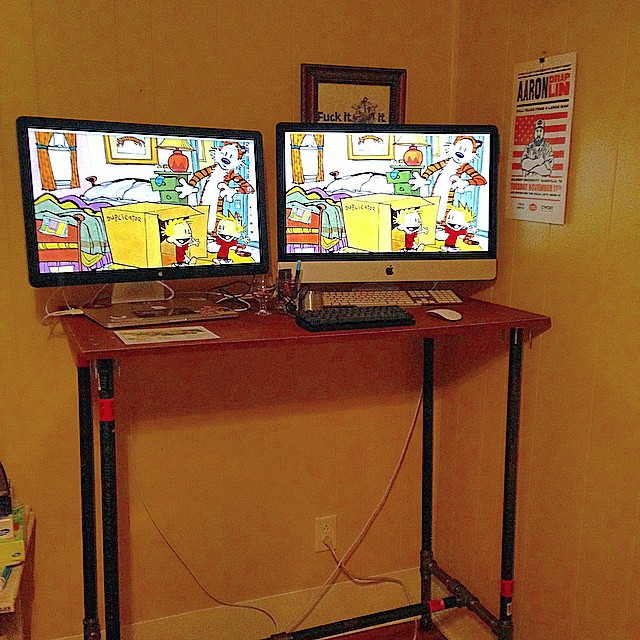
Building a Standing Desk
In June, I planned some time off between leaving my agency job at GS&F and starting at Bright Bytes. What's a geek to do with time on his hands? Build a desk, that's what!
I figured on using readily available pipe since I didn't have access to a miter saw. I wanted to buy everything at one big box store and be done with it. Besides, those industrial pipe desks look so damn chic. The list for my final build is as follows:
Black Iron 1" Pipe
- 6 T-joints
- 4 flanges
- 4 end caps
- 2 1-inch extensions
- 3 couplings for the 1-inch extension
- 4 6-inch nipples
- 4 4-inch nipples
- 4 36-inch pieces
- 1 24-inch piece
- 1 18-inch piece
The Hardware
- 16 3x3/8 bolts
- 16 3/8 washers
- 16 3/8 nuts
Mah Tools
- Standard battery powered drill
- Pipe Wrench
- ViseGrips
- Various grits of sandpaper
Let's Talk About Pipe
Now at your box store of choice, you will no doubt run into two different options for pipe. The options are "black iron" and "galvanized" pipe. I chose the most pragmatic choice... The cheaper of the two. So most of my desk is black iron with a smattering of galvanized.
To Thread Or Thread Not
I read a lot of plan online that used kee-klamps. These clamps removed the need of threading the pipe together. It made the desks somewhat adjustable too.
Queue the sad trombone, the box store didn't carry those clamps.
How I Put My Desk Together
With all of the parts laid out, the task ahead looked really cool. I'll admit now I made some mistakes. I'll cover those near the end. So some of the pictures may not be the way things turned out.
I started by making the cross members. I attached one t-joint to one of the 1-inch extensions and 1-inch coupling.
After making both cross member pieces, I started on the legs. I screwed the endcap into the 8-inch nipple then into the t-joint. I later swapped out the 8-inch pieces for 4-inch nipples.
I attached the legs to the cross members with the 6-inch nipples.
At this point I realized I made the base too wide. So I removed one of the 1-inch extensions and couples.
I used a coupling to connect the two remaining pipes (24-inch, 18-inch) to make the full-length cross member. That rounded out the complete base.
From that point, I attached the upper legs to the base and attached the flanges to the top of the legs.
I turned it all upside down, took a pencil and made marks in the holes of the flanges. I drilled through the pencil marks. I attached the top to the base with the nuts and bolts.
Here's the completed desk. It was one neat project to complete. I'll probably end up swapping out the top with some hand-milled lumber, but right now the plywood is holding strong.